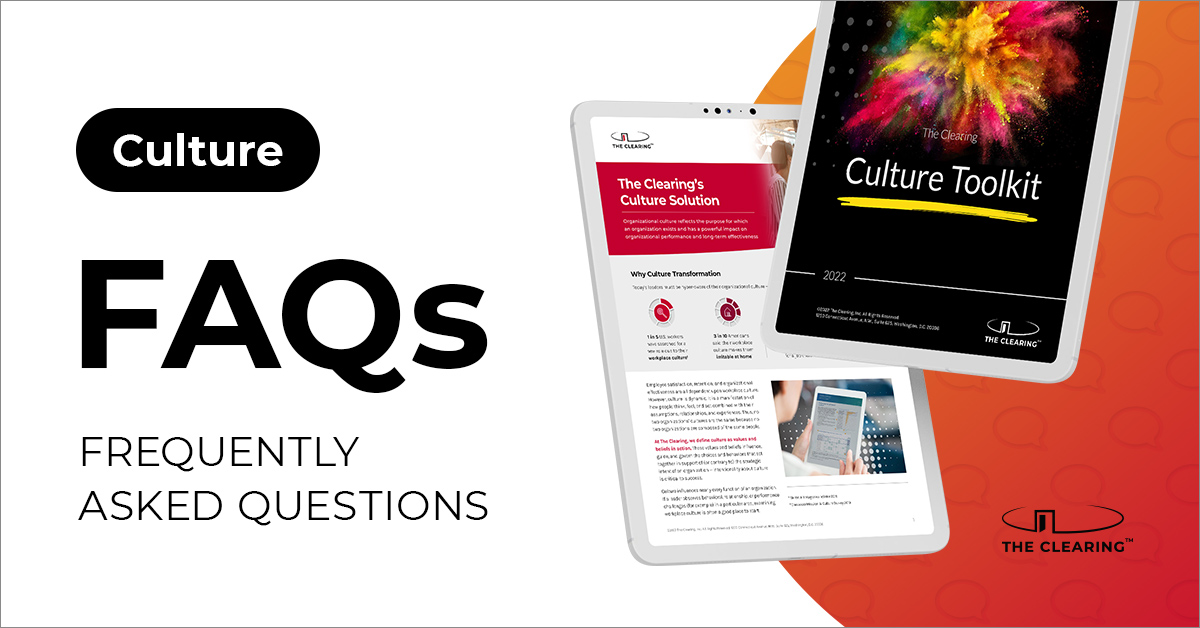When speaking to customers about their most pressing challenges, we receive a lot of questions about our Solution Areas. From how we approach the work to questions about specific challenges, these conversations with prospective customers and partners help us better understand what’s top of mind for folks – and how we at The Clearing can best help them create a path to success.
Over the years, we’ve noted certain questions tend to be asked more than others. With that in mind, I have the pleasure of introducing a new blog series: Solution Area FAQs. Today, I’ll be covering the questions we regularly receive when discussing workplace culture. Over the next several weeks, our experts in Leadership, Strategy, Customer Experience, and more will share the most-asked questions about their Solution Areas.
Without further ado, here are our Culture FAQs – and, of course, our answers.
Question 1: Everything Seems Fine. Why Should I Pay Attention to Culture?
If you’re one of the millions who love Survivor, you’ll appreciate this anecdote. One thing that is abundantly clear after 42 seasons: there are always new ways to outwit, outlast, and outplay. Every season there are new advancements in the way people play – from castaways forming voting blocs to making a compelling case about your strategy at the final Tribal Council. An effective strategy in one season does not guarantee a million dollars in the next.
The smart teams work to improve whether there are obvious signs of struggle or not. Think of culture the same way. While there may not be obvious challenges, intentionally working to improve culture is the best way (dare I say only way) to ensure your team’s sustained continued success.
Question 2: Why Does Culture Change Take So Long?
Leaders are consistently surprised by how long it takes to shift workplace culture. At The Clearing, we think of Culture as values and beliefs in action. Culture functions like a living, breathing organism that forms a web across an organization. That means there’s no switch you can flip to change it, no one person that controls it, and it’s never one size fits all. The result is that a leader or consultant can’t just tell someone what to do and then the culture work is done.
My colleagues and I were recently working with an organization to implement a hybrid work environment. In the beginning, our client partners were solely interested in the tactical aspects of hybrid working. What supplies do employees need? What communication tool will team members use in the new model? Of course, those questions (and answers) are part of the implementation. However, implementing a new working model will have a cultural impact far beyond supplies.
Think about the cultural spider web in your workplace. Physically separating people naturally causes some of those strands to fray. Deteriorating relationships (either formal or informal) may cause deteriorating productivity. The greatest communication tools can’t fix that alone. However, building and encouraging new habits around when and how often employees communicate in the hybrid model can.
And that’s where the time commitment comes in. Research shows it takes an average of 66 days for a person to establish a new behavior, with the range falling between 18 and 254 days. Now, extrapolate that across an organization, and you begin to see why culture change often isn’t quick.
Once our clients realized that culture change is as much about the “what” as the “how,” the length of the process no longer seemed unreasonable. With that mutual understanding, we helped them develop both the tactical plan and identify what behaviors were necessary to shift how they work with one another. Those behaviors were based on the desired experience that they wanted their folks to have in the new hybrid work environment.
Question 3: How Do You Measure Culture?
There is no shortage of statistics touting the ways culture-focused organizations outperform organizations where a premium isn’t placed on engagement. However, we’re often asked if you can actually measure culture on a scale of good to bad. Our response is that we prefer to measure culture through a competing values framework.
In fact, The Clearing team is developing an organizational culture assessment tool based on this principle – designed to allow organizations to understand the current state of their culture, measure and document the lived experiences of its people, and establish a baseline that can be tracked and measured over time. Here’s how it works.
One of the competing values in the assessment centers on achievement versus affiliation. Do people organize their work and move through the world based on things they’ve achieved (e.g., advanced degrees, certifications, job titles)? Or do they move through the world based on who they know and are affiliated with? This allows an organization to assess which has more value in their current culture – a specific degree or who people know – and determine if it reinforces desired or undesired behaviors within the organization.
The full assessment has ten competing values, which helps organizations measure culture on a spectrum of factors and decide if those values align with their stated mission and desired culture.
What’s Next?
Culture is often thought of in an abstract way, and the first way to begin to understand and shape it in your organization is to talk about it. I’d love to be part of the conversation with your organization. As you have more questions about workplace culture or if you are interested in our organizational culture assessment, please contact me at andrea.bachinski@theclearing.com.


 The Clearing’s Employee Experience
Improvement model, adapted from Itam
& Ghosh, 2020, focuses on three objectives:
The Clearing’s Employee Experience
Improvement model, adapted from Itam
& Ghosh, 2020, focuses on three objectives: 


















